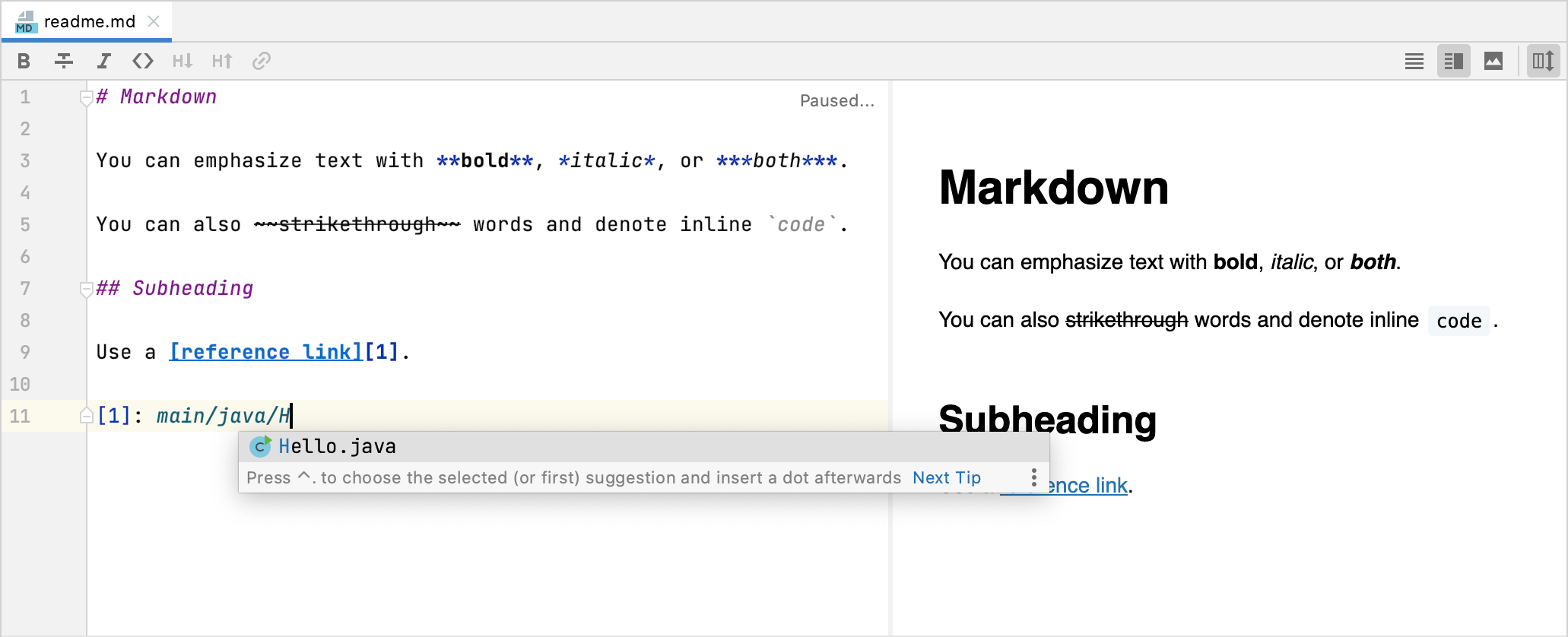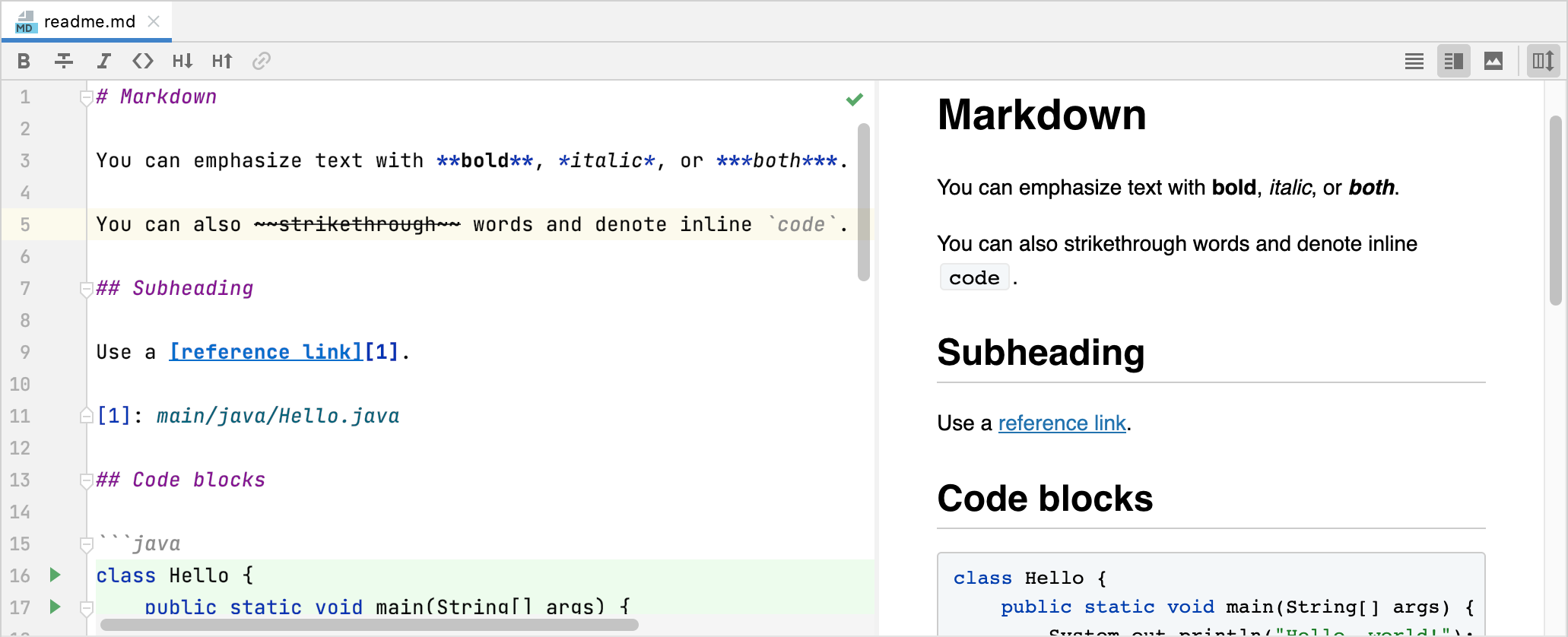Markdown
Required plugin: Markdown (bundled)
Configure: Settings/Preferences | Languages & Frameworks | Markdown
Filename patterns: *.md and *.markdown
Markdown is a lightweight markup language for adding formatting elements to plain text. RubyMine recognizes Markdown files, provides a dedicated editor with highlighting, completion, and formatting, and shows the rendered HTML in a live preview pane.
Create a new Markdown file
By default, RubyMine recognizes any file with the .md or .markdown extension as a Markdown file.
Right-click a directory in the Project tool window Alt+1 and select New | File.
Alternatively, you can select the necessary directory, press Alt+Insert, and then select File.
Enter a name for your file with a recognized extension, for example: readme.md.
The Markdown editor provides several basic formatting actions in the toolbar:
: Bold
: Strikethrough
: Italic
: Code
: Decrease heading level
: Increase heading level
: Convert an inline link to a reference link
You can use the preview pane to see the rendered HTML.

There is also completion for links to files in the current project, for example, if you need to reference source code, images, or other Markdown files.
Code blocks
To insert a fenced code block, use triple backticks (```) before and after the code block. If you specify the language for the code block, by default, the Markdown editor injects the corresponding language. This enables syntax highlighting and other coding assistance features for the specified language: code completion, inspections, and intention actions.

Disable coding assistance in code blocks
If your code blocks are not meant to be syntactically correct, you may want to disable code injection and syntax errors in code blocks.
In the Settings/Preferences dialog Ctrl+Alt+S, select Languages & Frameworks | Markdown.
Configure the following options:
Disable automatic language injection in code fences Do not inject any coding assistance for code blocks. Hide errors in code fences Do not check the syntax for errors. Click OK to apply the changes.
Diagrams
The Markdown editor can render diagrams defined with Mermaid and PlantUML. This is disabled by default and requires the corresponding Markdown extensions.

Enable diagram support
In the Settings/Preferences dialog Ctrl+Alt+S, select Languages & Frameworks | Markdown.
Enable either Mermaid or PlantUML under Markdown Extensions.
After RubyMine downloads the relevant extensions, click OK to apply the changes.
HTML preview
By default, the Markdown editor shows a preview pane next to it for rendered HTML code based on the Markdown file. You can use or
in the top right corner of the Markdown editor to show only the editor or the preview pane.
The scrollbars in the editor and in the preview pane are synchronized, meaning that the location in the preview pane corresponds to the location in the source. To disable this, click in the top right corner of the Markdown editor.
To split the editor and preview pane horizontally (top and bottom) instead of the default vertical split, in the Settings/Preferences dialog Ctrl+Alt+S, select Languages & Frameworks | Markdown, and then select Split horizontally under Editor and Preview Panel Layout.

Custom CSS
RubyMine provides default style sheets for rendering HTML in the preview pane. These style sheets were designed to be consistent with the default UI themes. You can configure specific CSS rules to make small presentation changes (for example, change the font size for headings or line spacing in lists) or you can provide an entirely new CSS to better match your expected output (for example, if you want to replicate the GitHub Markdown style).

In the Settings/Preferences dialog Ctrl+Alt+S, select Languages & Frameworks | Markdown.
Configure the settings under Custom CSS:
Select Load from URI to specify the location of a custom CSS file.
Select Add CSS rules rules to enter specific CSS rules that you want to override.
Reformat Markdown files
RubyMine can format Markdown files with proper line wrappings, blank lines, and indentation. For more information, see Reformat and rearrange code.
From the main menu, select Code | Reformat Code or press Ctrl+Alt+L.
RubyMine formats the contents according to the code style settings for Markdown files.
Configure Markdown code style settings
In the Settings/Preferences dialog Ctrl+Alt+S, select Editor | Code Style | Markdown.
Markdown code style settings include the following:
Configure the options for breaking lines.
| Hard wrap at | Specify at which column to put a line break. RubyMine shows a vertical line at the specified column and breaks lines between words, not within words. |
| Wrap on typing | Add line breaks as you type. Disable this option to add line breaks only when RubyMine performs formatting. |
| Visual guides | Show an additional vertical line at the specified column. |
Productivity tips
Customize highlighting for Markdown
RubyMine highlights various Markdown elements according to the color scheme settings.
In the Settings/Preferences dialog Ctrl+Alt+S, select Editor | Color Scheme | Markdown.
Select the color scheme, accept the highlighting settings inherited from defaults, or customize them as described in Configure colors and fonts.
Navigate in a large Markdown file
Use the Structure tool window Alt+7 or the File Structure popup Ctrl+F12 to view and jump to the relevant headings.
Add comments to a Markdown file
Markdown does not have dedicated syntax for commenting out lines. However, it is possible to emulate a comment line using a link label without an address, like this:
[comment]: <> (Your comment text)note
There must be a blank line before the link label.
Put the caret at the line that you want to comment out and press Ctrl+/.
This will add a link label with the commented out text in parentheses and a blank line before it if necessary. Press the same shortcut to uncomment.